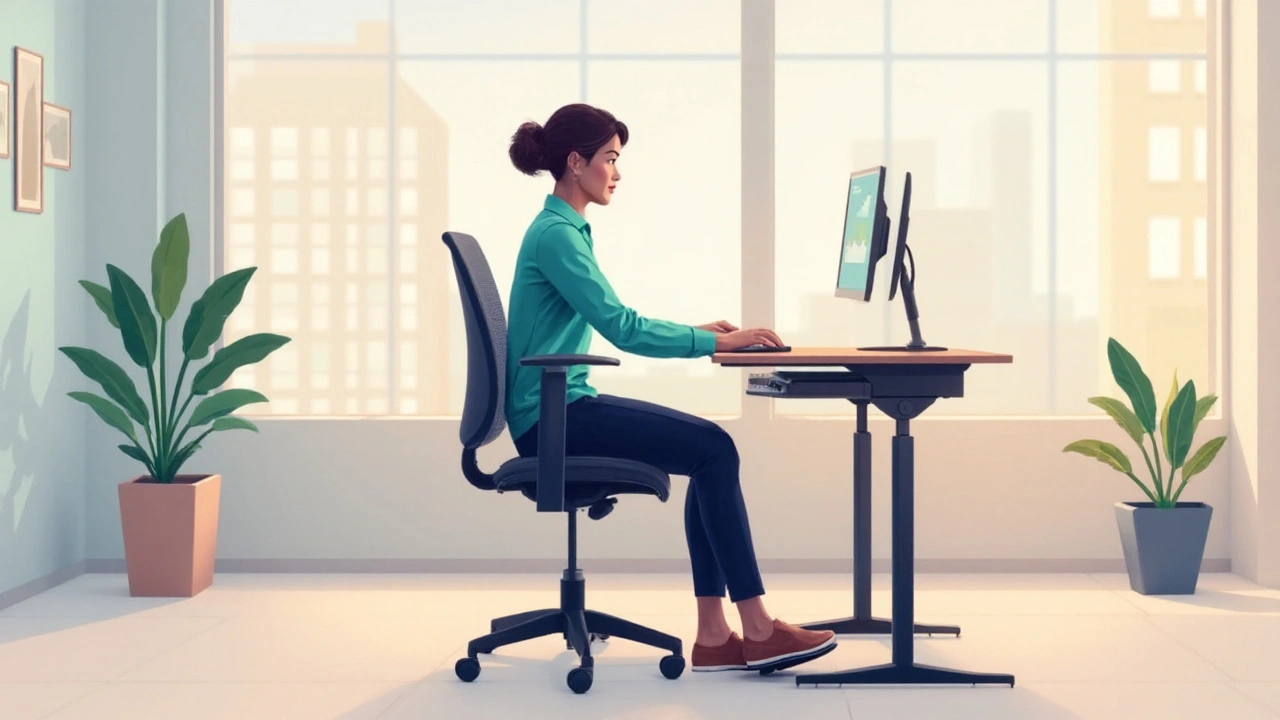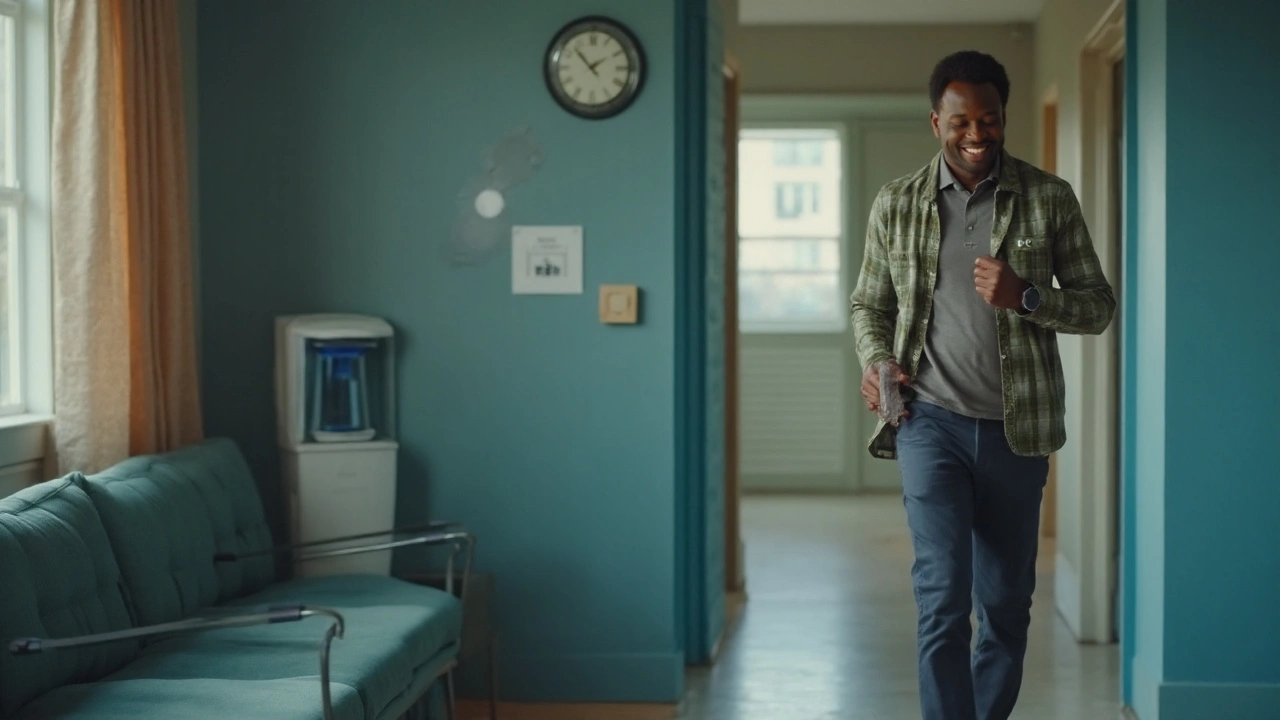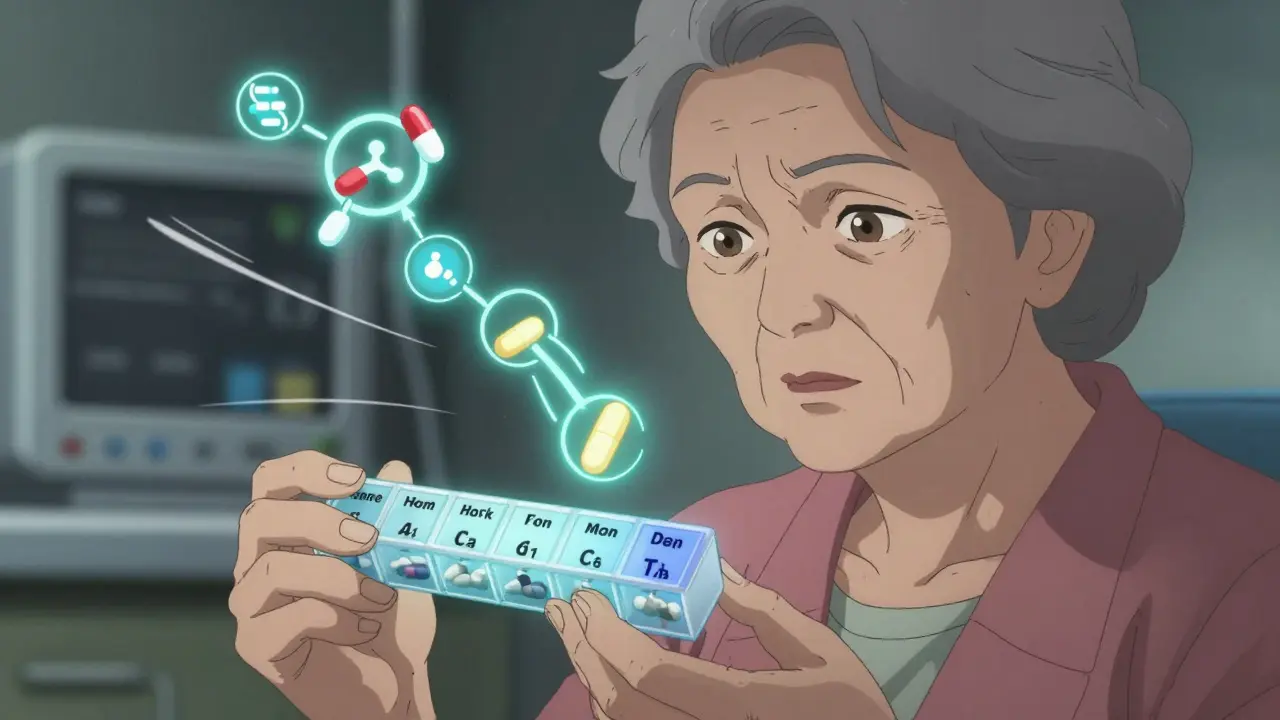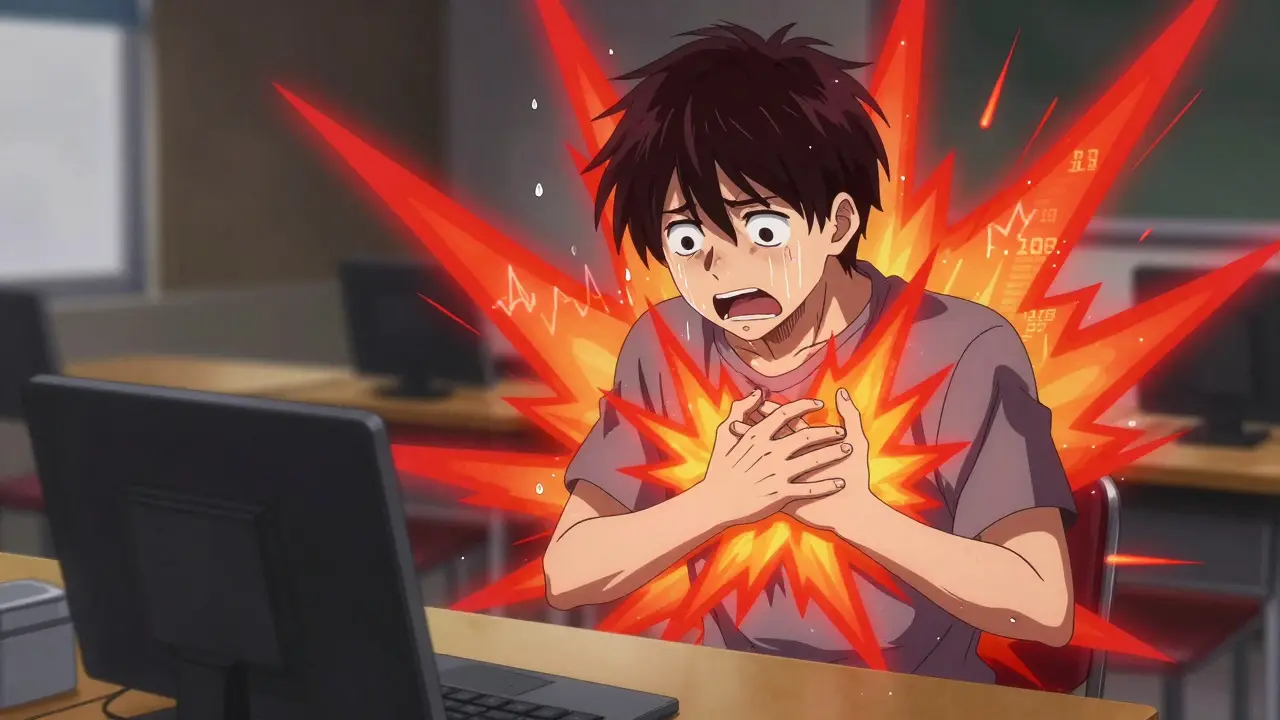Coping with Bladder Pain at Work: Practical Tips for a Comfortable Day

Bladder pain is a discomfort or burning sensation in the lower abdomen caused by inflammation, infection, or muscle tension, often triggered by prolonged sitting, dehydration, or urinary tract issues.
Understanding What Triggers Bladder Pain During Office Hours
Most office workers notice a flare‑up after a few hours of sitting. The main culprits are:
- Limited restroom access - a locked bathroom or long queues increase holding time.
- Poor hydration - sipping coffee without water concentrates urine, irritating the bladder lining.
- Muscle strain - slouching or using an unsupportive chair puts pressure on the pelvic floor.
- Underlying conditions - such as interstitial cystitis (a chronic bladder inflammation causing frequent pain) or a urinary tract infection (bacterial infection of the urinary system).
Quick‑Fix Strategies You Can Use at Your Desk
When the ache strikes, these low‑effort moves can bring relief without disrupting work.
- Stand up and stretch for 30 seconds - target the hips, lower back, and inner thighs.
- Apply a heat pack (a reusable gel pack warmed in hot water) to the lower abdomen for 5‑10 minutes.
- Take a short bathroom break - even a quick pee helps flush irritants.
- Drink a glass of room‑temperature water to hydrate the bladder walls.
- Perform a quick pelvic floor exercise (Gentle contractions to relax the pelvic muscles) by squeezing and releasing the muscles that stop urine flow.
Long‑Term Lifestyle Adjustments for Ongoing Comfort
These habits reduce the frequency and intensity of pain over weeks and months.
- Hydration schedule: Aim for 1.5-2L of water a day, split into 8‑10 small glasses. Set a reminder on your phone or desktop.
- Ergonomic chair: Choose a chair with lumbar support and adjustable height to keep your hips level with knees, lessening pelvic pressure.
- Scheduled bathroom breaks: Every 90 minutes, stand up and walk to the restroom, even if you don’t feel the urge.
- Stress management: Practice deep‑breathing or a 2‑minute mindfulness session to lower cortisol, which can heighten bladder sensitivity.
- Diet tweaks: Limit caffeine, alcohol, and acidic foods that irritate the bladder lining.

When Over‑The‑Counter Relief Helps
If quick fixes aren’t enough, a short‑term medication plan may be appropriate.
| Option | Typical Use | Onset (minutes) | Key Benefit |
|---|---|---|---|
| Heat pack | Apply to lower abdomen | 5-10 | Muscle relaxation, increased blood flow |
| Cold compress | Apply for 10min | 5-7 | Reduces swelling, numbs pain |
| Ibuprofen 200mg | Oral tablet | 15-30 | Anti‑inflammatory, pain reduction |
| Phenazopyridine | Oral tablet | 30-60 | d>Urinary tract analgesic (temporary relief)
Always check with a healthcare professional before starting a new medication, especially if you have kidney issues or are pregnant.
Creating a Bladder‑Friendly Workplace Environment
Employers can play a big role in reducing discomfort. Here are three practical changes:
- Designated restroom windows: Keep at least one bathroom unlocked during core hours.
- Hydration stations: Provide filtered water dispensers and encourage regular sipping.
- Ergonomic assessments: Offer a quick desk‑setup review every six months.
When management embraces these tweaks, the whole team feels healthier and more productive.
Related Topics to Explore Next
If bladder pain is affecting you, you may also want to read about:
- Interstitial cystitis management
- Stress‑induced urinary symptoms
- Office ergonomics for pelvic health

Frequently Asked Questions
Can I work through bladder pain without medication?
Yes. Simple actions like regular stretching, staying hydrated, and using a heat pack can often keep the pain manageable for a full workday. If symptoms persist, see a doctor.
How often should I take bathroom breaks?
Aim for a break every 90 minutes. This prevents bladder over‑distention and reduces the risk of irritation. Set a discreet calendar reminder if you tend to forget.
Is coffee the main culprit for bladder pain?
Coffee is a common trigger because caffeine is a diuretic and can irritate the bladder lining. Switching to low‑acid tea or decaf can ease symptoms without sacrificing your caffeine habit.
What simple exercises can I do at my desk?
Try the "quick pelvic floor squeeze": gently contract the muscles you’d use to stop urine, hold for 3 seconds, then release. Repeat 10 times, three times a day. It helps relax tension that may be contributing to pain.
When should I see a doctor about bladder pain?
If the pain lasts more than a few days, is accompanied by blood in urine, fever, or you notice frequent urges (more than 8 times a day), book an appointment. Early diagnosis can rule out infection or chronic conditions.






Comments
Justyne Walsh
September 25, 2025 AT 01:53Oh great, another office tip for folks who can't hold it.
Callum Smyth
September 25, 2025 AT 03:00Staying proactive with simple moves can really ease the discomfort. A quick stretch every hour, a heat pack, and sipping water are easy wins. It’s awesome how a few minutes can keep you focused. Keep at it, you’ve got this! 😊
Xing yu Tao
September 25, 2025 AT 04:40The phenomenon of occupational bladder discomfort warrants careful physiological consideration. Prolonged static posture imposes mechanical stress upon the pelvic floor, potentially eliciting nociceptive signals. Dehydration accentuates urine concentration, thereby irritating the urothelium and aggravating hyperalgesia. Moreover, restricted restroom accessibility may compel voluntary urinary retention, a known precipitant of detrusor overactivity. Empirical studies have demonstrated that periodic ambulation mitigates such adverse effects through enhanced pelvic circulation. Implementing a regimented schedule of standing breaks aligns with ergonomic best practices endorsed by occupational health agencies. The incorporation of thermotherapy, specifically a reusable heat pack, facilitates smooth muscle relaxation via increased local blood flow. Concurrently, gentle pelvic floor contractions-performed in a controlled manner-serve to recalibrate muscular tone. Nutritional modulation, including limitation of caffeine and acidic foods, further reduces irritative bladder stimuli. Hydration protocols recommending approximately 1.5 to 2 liters of water daily have been substantiated by clinical guidelines. It is advisable to distribute fluid intake evenly across the workday to avoid abrupt diuresis. In the presence of chronic conditions such as interstitial cystitis, a multidisciplinary approach involving urology, physiotherapy, and behavioral therapy is prudent. Pharmacologic adjuncts, when judiciously applied, may complement non‑pharmacologic strategies, yet they should be prescribed following thorough evaluation. Employers who facilitate unlocked restrooms and provide hydration stations contribute to a supportive occupational environment. Ultimately, a synthesis of ergonomic adjustments, scheduled voiding, and mindful lifestyle choices constitutes a robust framework for ameliorating bladder pain in the workplace.
Adam Stewart
September 25, 2025 AT 05:46Taking those micro‑breaks really does the trick; I’ve felt the difference myself.
Selena Justin
September 25, 2025 AT 07:26Maintaining adequate hydration is paramount for bladder health, especially during long meetings. A glass of room‑temperature water every ninety minutes can prevent the concentration of irritants. Pairing hydration with brief standing intervals supports both circulation and pelvic comfort. Additionally, ergonomic chairs that promote proper lumbar alignment reduce undue pressure on the pelvic floor. Should the discomfort persist, consulting a healthcare professional can rule out infection or chronic conditions. Proactive self‑care is the cornerstone of a productive workday.
Bernard Lingcod
September 25, 2025 AT 08:33Great points! I’d add that setting a discreet calendar reminder helps keep the schedule consistent, even when you’re deep in a project.
Raghav Suri
September 25, 2025 AT 10:13In my experience, the simple habit of standing up for a quick stretch does more than just loosen muscles. It also nudges blood flow toward the lower abdomen, which can ease that burning sensation. If you’re stuck at a desk for hours, consider a brief walk to the restroom even if you don’t feel the urge. That habit keeps the bladder from staying full too long. Small changes add up over time.
Freddy Torres
September 25, 2025 AT 11:20Heat pack + stretch = instant relief.
Andrew McKinnon
September 25, 2025 AT 13:00Oh, the joys of corporate ergonomics-nothing screams ‘productive’ like a locked bathroom and endless coffee fumes. Your bladder’s basically on a roller coaster of irritation thanks to that caffeine blitz. Toss in a flimsy chair and you’ve got the perfect recipe for pelvic floor fatigue. Good thing the “quick‑fix” list is full of heat packs and ibuprofen, right? Guess we’ll all be pain‑free by next quarter.
Dean Gill
September 25, 2025 AT 14:40It’s truly heartening to see a comprehensive approach that blends immediate relief with long‑term lifestyle tweaks. The emphasis on regular movement resonates because even five minutes of standing can reset muscular tension. Hydration, as you noted, is not just about drinking water but about pacing intake to avoid overload. I also appreciate the suggestion of scheduled bathroom breaks, which normalizes the act of listening to bodily signals. The inclusion of mindfulness techniques adds a psychological dimension that many overlook. When stress levels dip, the autonomic nervous system is less likely to exacerbate bladder sensitivity. For those dealing with interstitial cystitis, such holistic strategies can serve as adjuncts to medical treatment. Employers who prioritize ergonomic assessments send a clear message that employee well‑being matters. In practice, setting up a simple reminder on your phone or desktop can make these habits stick. Keep sharing these insights; they empower us to take charge of our health amidst demanding work schedules.
Royberto Spencer
September 25, 2025 AT 16:20If we contemplate the bladder as a micro‑cosm of the self, its pain mirrors the suppressed anxieties of work life. By addressing the physical symptoms we indirectly untangle mental knots. The practical tips you listed act as a bridge between body and mind. Yet true relief emerges when we align daily routines with our deeper values. In that sense, ergonomic reform becomes a form of personal philosophy.
Annette van Dijk-Leek
September 25, 2025 AT 18:00What a fantastic guide!!! The heat‑pack trick alone could save countless afternoons!!! Hydration stations are a brilliant idea for office culture!!! Keep the positivity flowing, everyone!
Katherine M
September 25, 2025 AT 19:40The systematic presentation of both immediate and preventative measures provides a valuable framework for occupational health practitioners. By integrating ergonomic adjustments, fluid management, and stress reduction techniques, the guide aligns with evidence‑based recommendations. The inclusion of a concise FAQ further enhances usability for end‑users. Overall, this resource merits dissemination within corporate wellness programs. 😊
Bernard Leach
September 25, 2025 AT 21:20I think the biggest hurdle is getting people to actually remember to move and drink water it is easy to forget when the inbox is full this guide gives simple cues that can be built into daily workflow regular stretch breaks keep the pelvic floor from tightening and a quick heat pack can loosen muscles without a trip to the pharmacy setting a timer on the computer for bathroom breaks reminds the brain that the bladder needs attention and a supportive chair reduces pressure on the lower back and hips overall this approach blends physical comfort with productivity and it can be adopted by any team regardless of size
Shelby Larson
September 25, 2025 AT 23:00Honestly, if you ignore these simple steps you’re practically inviting chronic discomfort. The body sends clear signals, and it’s your responsibility to heed them. Staying hydrated, stretching, and using a heat pack are not optional luxuries-they’re basic self‑care. Anyone who claims otherwise is just making excuses. So start implementing these habits and you’ll feel definately better.
felix rochas
September 26, 2025 AT 00:40Don't be fooled by corporate wellness fluff!!! They're selling you the illusion of comfort while the real agenda is to keep you glued to the desk!!! Hydration stations? More like surveillance tools for monitoring your break patterns!!! Stay vigilant!!!
inder kahlon
September 26, 2025 AT 02:20A quick stretch and a sip of water can break the cycle. Consistency is key.
Dheeraj Mehta
September 26, 2025 AT 04:00I’ve tried the pelvic floor squeeze at my desk – works surprisingly well :)
Oliver Behr
September 26, 2025 AT 05:40Brilliant tips, especially the 90‑minute bathroom reminder – will try it tomorrow.
Tiffany W
September 26, 2025 AT 07:20Leverage synergistic ergonomics and fluid dynamics to optimize uro‑physiological resilience.